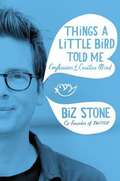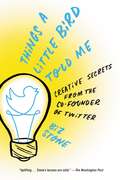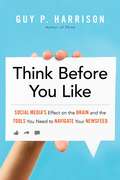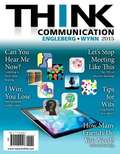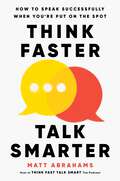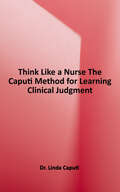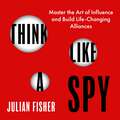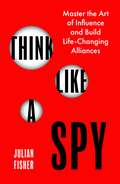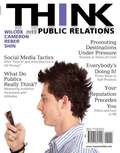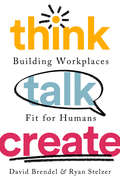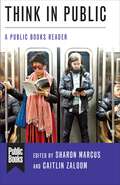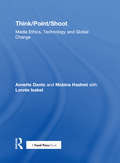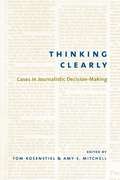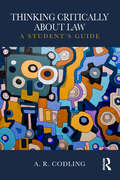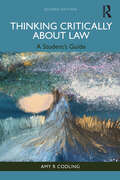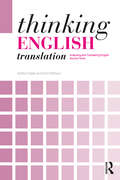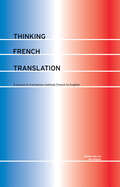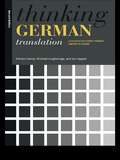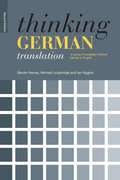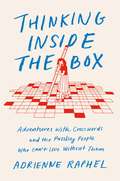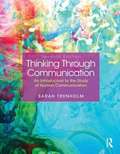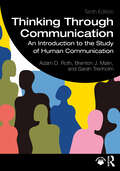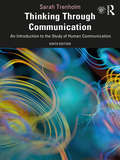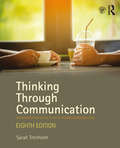- Table View
- List View
Things a Little Bird Told Me: Confessions of the Creative Mind
by Biz StoneBiz Stone, the co-founder of Twitter, discusses the power of creativity and how to harness it, through stories from his remarkable life and career. THINGS A LITTLE BIRD TOLD ME From GQ's "Nerd of the Year" to one of Time's most influential people in the world, Biz Stone represents different things to different people. But he is known to all as the creative, effervescent, funny, charmingly positive and remarkably savvy co-founder of Twitter-the social media platform that singlehandedly changed the way the world works. Now, Biz tells fascinating, pivotal, and personal stories from his early life and his careers at Google and Twitter, sharing his knowledge about the nature and importance of ingenuity today. In Biz's world: * Opportunity can be manufactured * Great work comes from abandoning a linear way of thinking * Creativity never runs out * Asking questions is free * Empathy is core to personal and global success. In this book, Biz also addresses failure, the value of vulnerability, ambition, and corporate culture. Whether seeking behind-the-scenes stories, advice, or wisdom and principles from one of the most successful businessmen of the new century, THINGS A LITTLE BIRD TOLD ME will satisfy every reader.
Things a Little Bird Told Me: Confessions of the Creative Mind
by Biz StoneBiz Stone, the co-founder of Twitter, discusses the power of creativity and how to harness it, through stories from his remarkable life and career.THINGS A LITTLE BIRD TOLD MEFrom GQ's "Nerd of the Year" to one of Time's most influential people in the world, Biz Stone represents different things to different people. But he is known to all as the creative, effervescent, funny, charmingly positive and remarkably savvy co-founder of Twitter-the social media platform that singlehandedly changed the way the world works. Now, Biz tells fascinating, pivotal, and personal stories from his early life and his careers at Google and Twitter, sharing his knowledge about the nature and importance of ingenuity today. In Biz's world:-Opportunity can be manufactured-Great work comes from abandoning a linear way of thinking-Creativity never runs out -Asking questions is free-Empathy is core to personal and global success In this book, Biz also addresses failure, the value of vulnerability, ambition, and corporate culture. Whether seeking behind-the-scenes stories, advice, or wisdom and principles from one of the most successful businessmen of the new century, THINGS A LITTLE BIRD TOLD ME will satisfy every reader.
Think Before You Like: Social Media's Effect on the Brain and the Tools You Need to Navigate Your Newsfeed
by Guy P. HarrisonAt a time when the news cycle turns on a tweet, journalism gets confused with opinion, and facts are treated as negotiable information, applying critical thinking skills to your social media consumption is more important than ever.Guy P. Harrison, an upbeat advocate of scientific literacy and positive skepticism, demonstrates how critical thinking can enhance the benefits of social media while giving users the skills to guard against its dangers.Social media has more than two billion users and continues to grow. Its widespread appeal as a means of staying in touch with friends and keeping up with daily news masks some serious pitfalls-- misinformation, pseudoscience, fraud, propaganda, and irrational beliefs, for example, presented in an attractive, easy-to-share form. This book will teach you how to resist the psychological and behavioral manipulation of social media and avoid the mistakes that millions have already made and now regret.Harrison presents scientific studies that show why your subconscious mind loves social media and how that can work against your ability to critically evaluate information. Among other things, social media reinforces your biases, clouds your judgment with images that leave a false impression, and fills your brain with anecdotes that become cheap substitutes for objective data. The very nature of the technology keeps you in a bubble; by tracking your preferences it sends only filtered newsfeeds, so that you rarely see anything that might challenge your set notions. Harrison explores the implications of having digital "friends" and the effects on mood, self-esteem, and the cultivation of friendship in the real world. He discusses how social media affects attention spans and the ability to consider issues in depth. And he suggests ways to protect yourself against privacy invasion, cyberstalking, biased misinformation, catfishing, trolls, misuse of photos, and the confusion over fake news versus credible journalism.
Think Communication (Third Edition)
by Isa N. Engleberg Dianna R. WynnUnderstand core communication concepts THINK Communication distills major communication concepts, theories, research, and trends into bite-size essentials, making learning human communication not only fun, but accessible and relatable. Students will find that THINK Communication's unique features help them to identify and understand their own communication behaviors, as well the communication behavior of others. MySearchLab is a part of the Engleberg program. Research and writing tools, including access to academic journals, help students understand critical thinking in even greater depth. To provide students with flexibility, students can download the eText to a tablet using the free Pearson eText app. Note: MySearchLab does not come automatically packaged with this text. To purchase MySearchLab, please visit: www. mysearchab. com or you can purchase a ValuePack of the text + MySearchLab (at no additional cost): ValuePack ISBN-10: 0205239927/ ValuePack ISBN-13: 9780205239924
Think Faster, Talk Smarter: How to Speak Successfully When You're Put on the Spot
by Matt AbrahamsDevelop the life-changing ability to excel in spontaneous communication situations—from public speaking to interviewing to networking—with these essential strategies from a Stanford lecturer, coach, and host of the popular Think Fast, Talk Smart The Podcast. &“A roadmap to mastering the art of thinking quickly and speaking confidently, this is the perfect book for…anyone else who talks.&” —Charles Duhigg, bestselling author of The Power of Habit, Smarter Faster Better and SupercommunicatorsMany of us dread having to convey our ideas to others, often feeling ill-equipped, anxious, and awkward. Public speaking experts help by focusing on planned communication experiences such as slide presentations, pitches, or formal talks. Yet, most of our professional and personal communication occurs in spontaneous situations that creep up on us and all too often leave us flustered and stumbling for words. How can we rise to the occasion and shine when we&’re put on the spot? In Think Faster, Talk Smarter, Stanford lecturer, podcast host, and communication expert Matt Abrahams provides tangible, actionable skills to help even the most anxious of speakers succeed when speaking spontaneously. Abrahams provides science-based strategies for managing anxiety, responding to the mood of the room, and making content concise, relevant, compelling, and memorable. Drawing on stories from his clients and students, he offers best practices for navigating Q&A sessions, shining in job interviews, providing effective feedback, making small talk, fixing faux pas, persuading others, and handling other impromptu speaking tasks. Whether it&’s a prospective client asking you an unexpected question during a meeting or all eyes turning to you at a dinner party, you&’ll know how to navigate the situation like a pro and bring out your very best. Think Faster, Talk Smarter is an accessible guide to communication that will help you master new techniques in no time.
Think Like a Nurse: The Caputi Method for Learning Clinical Judgment
by Linda CaputiOver 150 Colleges and Universities adopted the first edition of Think Like a Nurse: A Handbook as a required student textbook. These adoptions demonstrate a need for this clinical judgment framework and have motivated the author, Dr. Linda Caputi, to expand the Caputi Method for Learning Clinical Judgment. The overwhelming support from educational institutions is evidence that students must learn a clinical judgment framework as the basis for thinking in nursing today. Older methods of evaluating student thinking that relied solely on students correctly answering questions with the assumption that if they answer correctly, they can use clinical judgment, are fatally flawed. Students must learn a framework that is used to focus their thinking, stay mindful, and guide them to make sound clinical decisions.
Think Like a Spy: Master the Art of Influence and Build Life-Changing Alliances
by Julian Fisher'It's rare to find a book that is not only intensely personal but deeply practical. Julian Fisher has somehow pulled it off, in this fascinating and engaging guide to the art of influence. Think Like a Spy is a fantastic read, full of eye-opening espionage tradecraft as well as insightful tips on how to achieve your business goals. Highly recommended' - Henry Hemming, author of Four Shots in the NightDiscover the secret skills of influence and persuasion taught to intelligence officers and how to adapt them to win over personal and professional allies to your cause. Every day, intelligence officers achieve the unimaginable. They persuade people to share classified secrets with them. To become traitors, in fact. And their targets do it willingly, despite the risk of imprisonment, torture and, even, execution. Spies achieve this thanks to their structured use of nine secret skills of espionage. In Think Like a Spy, you'll learn these techniques and how to adapt them for effective and ethical use in your own life.A good spy is a people-person. She knows how to identify a potential agent, how to attract their attention and what to do to build an enduring relationship with them. From this base, she will coax out personal information to work out what makes her target tick. She will use that knowledge and her understanding of human psychology to her advantage while winning lasting commitment from her new ally.All these skills can be mastered and turned to use in civilian life. The author realised that he used all of them in his own progress from the poorest postcode in Britain to Oxford University, into a blue-blooded stockbroking firm, and on to a thrilling and varied career in the security and intelligence worlds. Julian uses a wide variety of stories from this journey to illustrate how spy skills can be adapted to situations and challenges that we all face.Everyone is capable of thinking like a spy and of using that thinking to transform their lives. This is your opportunity to learn how.
Think Like a Spy: Master the Art of Influence and Build Life-Changing Alliances
by Julian Fisher'It's rare to find a book that is not only intensely personal but deeply practical. Julian Fisher has somehow pulled it off, in this fascinating and engaging guide to the art of influence. Think Like a Spy is a fantastic read, full of eye-opening espionage tradecraft as well as insightful tips on how to achieve your business goals. Highly recommended' - Henry Hemming, author of Four Shots in the NightDiscover the secret skills of influence and persuasion taught to intelligence officers and how to adapt them to win over personal and professional allies to your cause. Every day, intelligence officers achieve the unimaginable. They persuade people to share classified secrets with them. To become traitors, in fact. And their targets do it willingly, despite the risk of imprisonment, torture and, even, execution. Spies achieve this thanks to their structured use of nine secret skills of espionage. In Think Like a Spy, you'll learn these techniques and how to adapt them for effective and ethical use in your own life.A good spy is a people-person. She knows how to identify a potential agent, how to attract their attention and what to do to build an enduring relationship with them. From this base, she will coax out personal information to work out what makes her target tick. She will use that knowledge and her understanding of human psychology to her advantage while winning lasting commitment from her new ally.All these skills can be mastered and turned to use in civilian life. The author realised that he used all of them in his own progress from the poorest postcode in Britain to Oxford University, into a blue-blooded stockbroking firm, and on to a thrilling and varied career in the security and intelligence worlds. Julian uses a wide variety of stories from this journey to illustrate how spy skills can be adapted to situations and challenges that we all face.Everyone is capable of thinking like a spy and of using that thinking to transform their lives. This is your opportunity to learn how.
Think Like a Spy: Master the Art of Influence and Build Life-Changing Alliances
by Julian Fisher'It's rare to find a book that is not only intensely personal but deeply practical. Julian Fisher has somehow pulled it off, in this fascinating and engaging guide to the art of influence. Think Like a Spy is a fantastic read, full of eye-opening espionage tradecraft as well as insightful tips on how to achieve your business goals. Highly recommended' - Henry Hemming, author of Four Shots in the NightDiscover the secret skills of influence and persuasion taught to intelligence officers and how to adapt them to win over personal and professional allies to your cause. Every day, intelligence officers achieve the unimaginable. They persuade people to share classified secrets with them. To become traitors, in fact. And their targets do it willingly, despite the risk of imprisonment, torture and, even, execution. Spies achieve this thanks to their structured use of nine secret skills of espionage. In Think Like a Spy, you'll learn these techniques and how to adapt them for effective and ethical use in your own life.A good spy is a people-person. She knows how to identify a potential agent, how to attract their attention and what to do to build an enduring relationship with them. From this base, she will coax out personal information to work out what makes her target tick. She will use that knowledge and her understanding of human psychology to her advantage while winning lasting commitment from her new ally.All these skills can be mastered and turned to use in civilian life. The author realised that he used all of them in his own progress from the poorest postcode in Britain to Oxford University, into a blue-blooded stockbroking firm, and on to a thrilling and varied career in the security and intelligence worlds. Julian uses a wide variety of stories from this journey to illustrate how spy skills can be adapted to situations and challenges that we all face.Everyone is capable of thinking like a spy and of using that thinking to transform their lives. This is your opportunity to learn how.
Think Public Relations (Second Edition)
by Dennis L. Wilcox Glen T. Cameron Bryan H. Reber Jae-Hwa ShinProvides an introduction to the field of public relations that successfully blends theory and practice. Students are introduced to exciting and innovative public relations campaign examples in the contract of relevant theory and core concepts that they will need to succeed in the world of public relations. The authors offer a practical approach to the study of public relations and emphasize competition and conflict management, while providing a concise, comprehensive overview of the profession. This program will provide a better teaching and learning experience for you and your students.
Think Talk Create: Building Workplaces Fit For Humans
by David Brendel Ryan StelzerA brilliant counter-narrative for restoring humanity to the bottom-line, numbers-obsessed culture of the modern, 21st century workplace. In a time of unusual stress, with a pandemic raging and economic insecurity and dislocation increasing, we need to rediscover the values that make us human, that give us a sense of meaning in order to increase our potential for productivity and success. What stands in the way, however, is a professional culture where human connectedness is a lost art: the frenzied numbers-obsessed, bottom-line thinking, the "scratch and claw" workplace, and organizations where the boss can literally be an algorithm. Through moving stories and a modern spin on the ancient framework of Socratic dialogue, David Brendel and Ryan Stelzer show how to move forward and build workplaces fit for humans through what uniquely defines us as human beings: our ability to think, talk, and create. By thinking carefully about a challenge, engaging peers in dialogue via open-ended questioning, and building a strategy collaboratively. Think Talk Create enables us to cultivate trust and define collective values, seemingly "soft" attributes that nonetheless markedly increase innovation and, ultimately, financial performance. Think: Step back, slow down, avoid impulsive, short-sighted decision making. Talk: Ask non-judgmental, open ended questions, with your mind as a blank slate, pursuing the problem like an empirical scientist or a judge presiding in court. Create: Bring something new and meaningful into play, a novel solution to a pesky problem that can move the world in surprising, positive directions.
Think in Public: A Public Books Reader (Public Books Series)
by Barbara Cassin Jill Lepore Judith Butler Kieran Setiya Fred Turner Jan Mieszkowski Jeremy Adelman Haruo Shirane Anne E. Fernald Matthew Engelke Imani Perry James Vernon Gayatri Chakravorty Spivak Kim Phillips-Fein Philip Gorski Frances Negrón-Muntaner Namwali Serpell Shannon Mattern Karen Dunak John Plotz Daegan Miller Christopher Schaberg Lilly Irani Joseph Jonghyun Jeon Suzy Hansen Max Holleran Mark McGurl Stacey Balkan Nathan Connolly Najwa Al-Qattan Destin Jenkins Andrew Perrin Lynn French Salamishah Tillet Matthew Clair Ursula K. Guin Eli Rosenblatt Rebecca Falkoff Karl Ashoka Britto Marah Gubar Tess McNulty Nicholas Dames John R. McNeillSince 2012, Public Books has championed a new kind of community for intellectual engagement, discussion, and action. An online magazine that unites the best of the university with the openness of the internet, Public Books is where new ideas are debuted, old facts revived, and dangerous illusions dismantled. Here, young scholars present fresh thinking to audiences outside the academy, accomplished authors weigh in on timely issues, and a wide range of readers encounter the most vital academic insights and explore what they mean for the world at large.Think in Public: A Public Books Reader presents a selection of inspiring essays that exemplify the magazine’s distinctive approach to public scholarship. Gathered here are Public Books contributions from today’s leading thinkers, including Jill Lepore, Imani Perry, Kim Phillips-Fein, Salamishah Tillet, Jeremy Adelman, N. D. B. Connolly, Namwali Serpell, and Ursula K. Le Guin. The result is a guide to the most exciting contemporary ideas about literature, politics, economics, history, race, capitalism, gender, technology, and climate change by writers and researchers pushing public debate about these topics in new directions. Think in Public is a lodestone for a rising generation of public scholars and a testament to the power of knowledge.
Think/Point/Shoot: Media Ethics, Technology and Global Change
by Annette Danto Mobina Hashmi Lonnie IsabelThink/Point/Shoot gives students a thorough overview of the role of ethics in modern media creation. Case studies emphasize the critical issues in global media ethics today in all stages of media creation from preproduction research and development, to production and post production. This volume features practicing filmmakers, journalists, and media creators who provide insight into dealing with real-world ethical dilemmas. For this era, digital imagery, sounds, and web communication have opened doors to sharing thoughts and ideas instantaneously to potentially vast audiences. This presents exciting opportunities, but also serious ethical, legal, and social challenges. The cases and exercises found in this book are applicable to the current media field while still remaining grounded in strong ethical theory. Think/Point/Shoot explains the challenge of communicating a story to a worldwide audience while maintaining ethical standards. A companion website provides additional resources for students and instructors: media ethics game chapter summaries and case studies important forms Instructors will also find: classroom exercises PowerPoints video from the "Global Media Ethics" Conference from March 2013
Thinking Clearly: Cases in Journalistic Decision-Making
by Tom Rosenstiel Amy MitchellWritten by leading professional journalists and classroom-tested at schools of journalism, Thinking Clearly is designed to provoke conversation about the issues that shape the production and presentation of the news in the twenty-first century. These case studies depict real-life moments when people working in the news had to make critical decisions. Bearing on questions of craft, ethics, competition, and commerce, they cover a range of topics—the commercial imperatives of newsroom culture, standards of verification, the competition of public and private interests, including the question of privacy—in a variety of key episodes: Watergate, the Richard Jewell case, John McCain's 2000 presidential campaign, and the Columbine shooting, among others.
Thinking Critically About Law: A Student's Guide
by A. R. CodlingSo you’ve arrived at university, you’ve read the course handbook and you’re ready to learn the law. But is knowing the law enough to get you the very best marks? And what do your lecturers mean when they say you need to develop critical and analytical skills? When is it right to put your own views forward? What are examiners looking for when they give feedback to say that your work is too descriptive? This book explores what it means to think critically and offers practical tips and advice for students to develop the process, skill and ability of thinking critically while studying law. The book investigates the big questions such as: What is law? and What is ‘thinking critically’? How can I use critical thinking to get better grades in assessments? What is the role of critical thinking in the work place? These questions and more are explored in Thinking Critically About Law. Whether you have limited prior experience of critical thinking or are looking to improve your performance in assessments, this book is the ideal tool to help you enhance your capacity to question, challenge, reflect and problematize what you learn about the law throughout your studies and beyond.
Thinking Critically About Law: A Student's Guide
by Amy R CodlingYou arrive at university to embark upon your journey to ‘think like a lawyer’, but is simply knowing the law enough to gain you the best marks? What do you need to do, exactly, to achieve a first-class law degree and promising professional career? For top marks, what do your lecturers mean when they say you need to deepen your ‘critical analysis’ to answer assessment questions? When should you put your own viewpoints forward? When, and how, should you draw upon the work of others? What do your examiners mean when they give you feedback saying that your work is ‘too descriptive’? This book explores what it means to think critically and offers practical tips and advice for students to develop the process, skill and ability of thinking critically while studying law, as well as beyond that in the workplace.The second edition of Thinking Critically About Law utilises art, music, poetry and prose to explore essential questions about studying law and what it means to think critically, offering practical tips and advice for students looking to develop critical thinking skills in relation to law. Updates reflect seismic changes that have taken place both in law teaching and in society more generally. These include the Covid-19 pandemic, social movements sparked by the murders of murders of Sarah Everard and George Floyd, moves to decolonise the law curriculum and the introduction of the SQE qualification. There is also an innovative foreword by Professor Russell Sandberg, a new chapter on the topic of how to think critically during discussions, a new section on Thinking Critically About Law in the Future as well as a renewed emphasis on the health and well-being of students. Other student-focused resources will be available as support materials.Thinking Critically about Law is a crucial companion for those studying law at A-Level and undergraduate level, as well as being relevant to postgraduate students, newly qualified lawyers and tutors of law.
Thinking English Translation: Analysing and Translating English Source Texts (Thinking Translation)
by Stella Cragie Ann PattisonThinking English Translation is a practical guide to analysing and translating English source texts. Section I focuses on pre-translation analysis where students are guided to consider the features of a variety of English texts and the various implications for translation into other languages. Section II examines language variety in English in more detail and provides strategies for dealing with translation challenges in a wide range of text types. Thinking English Translation gives students a framework for a better understanding of how to approach source texts in order to tackle translation assignments, whether in class or in the workplace, with confidence. Stella Cragie a Qualified Member of the Institute of Translation and Interpreting, and former Principal Lecturer in Translation at the University of Westminster, is now a freelance translator. Ann Pattison is a former Senior Lecturer in Translation at the University of Westminster and now works as a freelance translator, editor and writer.
Thinking French Translation (Thinking Translation)
by Ian Higgins Sándor HerveyThe new edition of this popular course in translation from French into English offers a challenging practical approach to the acquisition of translation skills, with clear explanations of the theoretical issues involved. A variety of translation issues are considered including:*cultural differences*register and dialect*genre*revision and editing.The course now covers texts from a wide range of sources, including:*journalism and literature*commercial, legal and technical texts*songs and recorded interviews.This is essential reading for advanced undergraduates and postgraduate students of French on translation courses. The book will also appeal to wide range of language students and tutors.A tutors' handbook offering invaluable guidance on how to use the text is available for free download at http://www.routledge.com/cw/thinkingtranslation/
Thinking German Translation: A Course in Translation Method (Thinking Translation)
by Ian Higgins Sándor Hervey Michael Loughridge Mr Ian HigginsThinking German Translation is a comprehensive and revolutionary 20-week course in translation method offering a challenging and entertaining approach to the acquisition of translation skills. It has been fully and successfully piloted at the University of St.Andrews.Translation is presented as a problem-solving discipline. Discussion, examples and a full range of exercise work enable students to acquire the skills necessary for a broad range of translation problems.Examples are drawn from a wide variety of material from technical and commercial texts to poetry and song.Thinking German Translation is essential reading for advanced undergraduates and postgraduate students of German. The book will also appeal to a wide range of languages students and tutors through the general discussion of principles, purposes and practice of translation.
Thinking German Translation: Teacher's Handbook (Thinking Translation)
by Ian Higgins Sandor Hervey Michael LoughridgeThis is a comprehensive practical course in translation for advanced students of German, which focuses on improving translation quality whilst clarifying the theoretical issues involved. This second edition brings the course up-to-date, and has been fully reworked to give clearer explanations of key terms and include revised chapters on genre, compensation and revision and editing. Based on detailed analysis of translation problems, Thinking German Translation features new material taken from a wide range of sources, including: business and politics press and publicity engineering tourism literary and consumer-oriented texts. Addressing a variety of translation issues such as cultural difference, register and dialect, Thinking German Translation is essential reading for all students wishing to perfect their translation skills. It is also an excellent foundation for those considering a career in translation. Further resources, including a free teacher's handbook for the course, are available on the companion website at http://cw.routledge.com/textbooks/0415341469/resources/default.asp
Thinking Inside the Box: Adventures with Crosswords and the Puzzling People Who Can't Live Without Them
by Adrienne Raphel'Beautifully researched account, full of humour and personal insight'David Crystal, author of Making Sense: The Glamorous Story of English Grammar'A witty, wise, and wonderfully weird journey that will change the way you think . . . This book is a delight'Bianca Bosker, author of Cork Dork: A Wine-Fueled Adventure Among the Obsessive Sommeliers, Big Bottle Hunters, and Rogue Scientists Who Taught Me to Live for Taste'Delightfully engrossing, charmingly and enthusiastically well-written history of the crossword puzzle' Benjamin Dreyer, author of Dreyer's English: An Utterly Correct Guide to Clarity and Style 'Full of treasures, surprises and fun . . . richly bringing to life the quirky, obsessive, fascinating characters in the crossword world' Mary Pilon, author of The Monopolists: Obsession, Fury, and the Scandal Behind the World's Favorite Board Game 'A gold mine of revelations. If there is a pantheon of cruciverbalist scholars, Adrienne Raphel has established herself squarely within it'Mary Norris, author of Between You & Me: Confessions of a Comma QueenEqual parts ingenious and fun, Thinking Inside the Box is a love letter to the infinite joys and playful possibilities of language, a treat for die-hard cruciverbalists and first-time crossword solvers alike.The crossword is a feature of the modern world, inspiring daily devotion and obsession from millions. It was invented in 1913, almost by accident, when an editor at the New York World was casting around for something to fill some empty column space for that year's Christmas edition. Almost overnight, crosswords became a phenomenal commercial success, and have been an essential ingredient of any newspaper worth its salt since then. Indeed, paradoxically, the popularity of crosswords has never been greater, even as the world of media and newspapers, the crossword's natural habitat, has undergone a dramatic digital transformation. But why, exactly, are the satisfactions of a crossword so sweet that over the decades they have become a fixture of breakfast tables, bedside tables and commutes, and even given rise to competitive crossword tournaments?Blending first-person reporting from the world of crosswords with a delightful telling of the crossword's rich literary history, Adrienne Raphel dives into the secrets of this classic pastime. At the annual American Crossword Puzzle Tournament, she rubs shoulders with elite solvers from all over the world, doing her level best to hold her own; aboard a crossword-themed cruise she picks the brains of the enthusiasts whose idea of a good time is a week on the high seas with nothing to do but crosswords; and, visiting the home and office of Will Shortz, New York Times crossword puzzle editor and US National Public Radio's official Puzzlemaster, she goes behind the scenes to see for herself how the world's gold standard of puzzles is made.
Thinking Through Communication
by Sarah TrenholmPraised for its teachability, Thinking Through Communication provides an excellent, balanced introduction to basic theories and principles of communication, making sense of a complex field through a variety of approaches. In an organized and coherent manner, Thinking Through Communication covers a full range of topics- from the history of communication study to the methods used by current communication scholars to understand human interaction. The text explores communication in a variety of traditional contexts: interpersonal, group, organizational, public, intercultural, computer-mediated communication and the mass media. This edition also offers new insights into public speaking and listening. This text can be used successfully in both theory- and skills-based courses. Written in a clear, lively style, Trenholm's overall approach-including her use of examples and interesting illustrations-helps both majors and non-majors alike develop a better understanding of communication as a field of study and an appreciation for ways in which communication impacts their daily lives.
Thinking Through Communication: An Introduction to the Study of Human Communication
by Sarah Trenholm Adam Roth Brenton MalinThis fully updated tenth edition for hybrid introductory communication courses provides a balanced introduction to the fundamental theories and principles of communication.The book explores communication in a variety of contexts, including interpersonal, group, organizational, and mass media. It provides students with the theoretical knowledge and the research and critical thinking skills they will need to succeed in advanced communication courses and professions. Organized into three parts, this new edition first explores the history of communication studies and explains the basic perspectives used by scholars in the field. Part II looks at how language and listening take place in small and large groups. Part III then examines global, institutional, and public communication. This edition includes an additional chapter on research methods, reflects the changing nature and norms of communication in the workplace, and provides a post-COVID assessment of models, methods, and evaluations of telecommuting practices. The appendix gives users the flexibility to tailor their courses to the interests and needs of their students, offering guidelines for preparing and presenting public presentations and giving examples of major research methods.Thinking Through Communication is an ideal textbook for Introduction to Communication courses that aim to provide a comprehensive overview of the field.Material for instructors including PowerPoint slides, test questions, and an instructor’s manual are available at www.routledge.com/9781032499079.
Thinking Through Communication: An Introduction to the Study of Human Communication
by Sarah TrenholmThe ninth edition of this textbook for hybrid introductory communication courses provides a balanced introduction to the fundamental theories and principles of communication. The book explores communication in a variety of contexts—including interpersonal, group, organizational, and mass media—and provides students the theoretical knowledge and the research and critical thinking skills they’ll need to succeed in advanced communication courses and professions. The first section explores the history of communication study and explains basic perspectives used by scholars in the field. The second looks at how communicators decode and encode messages, while the third examines channels and contexts, from interpersonal to mass media. This edition devotes attention to how new technologies are changing the ways we think about communication, with revised and updated examples, and gives special attention to relevant critical theory. Two appendices give users the flexibility to tailor their courses to the interests and needs of their students, offering guidelines for preparing and presenting public presentations and giving examples of major research methods. Thinking Through Communication is an ideal textbook for Introduction to Communication courses that aim to provide a comprehensive overview of the field. A companion website for instructors containing PowerPoint slides, test questions, and an instructor’s manual is available at https://routledgetextbooks.com/textbooks/9780367857011.
Thinking Through Communication: An Introduction to the Study of Human Communication (Mycommunicationkit Ser.)
by Sarah TrenholmNow in its eighth edition, Thinking Through Communication provides a balanced introduction to the fundamental theories and principles of communication. It explores communication in a variety of contexts—from interpersonal to group to mass media—and can be used in both theoryand skills-based courses. With a dynamic approach, Trenholm helps students to develop a better understanding of communication as a field of study, as well as its practical applications. This edition devotes attention to how new technologies are changing the ways we think about communication, with revised chapters on both traditional and social media.
